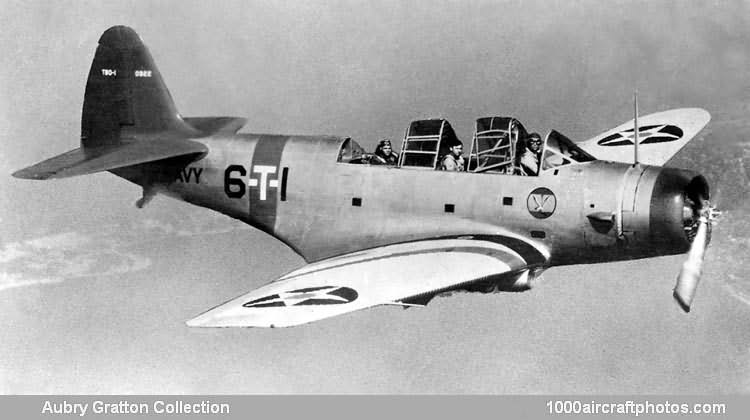12/31/2010. Remarks by Johan Visschedijk: "For operation from a new family of aircraft carriers, starting with the USS Ranger of 1934, the USN initiated development of a new torpedo-bomber during the same year. Prototypes were ordered on June 30 from both Douglas and the Great Lakes Company, the respective designs being for a monoplane and a biplane. In positive manner, therefore, this particular design competition marked the point of transition from biplane to monoplane in torpedo-bombers, for the Great Lakes XTBG-1 was the last of the biplanes in this category, and the Douglas XTBD-1 was the prototype of what was to become the USN's first carrier-based monoplane in production.
The layout of the XTBD-1 was typical of its era. Associated with the low wing was a semi-retractable landing gear, the main wheels protruding from the wings when retracted to give some protection in the event of a forced landing. Folding wings were no novelty on a carrier-based aircraft, but the upward fold of the XTBD-1 was unusual, as was the provision for powered actuation of the wings. The crew of three was carried in tandem beneath a single long enclosure and the engine was an 800 hp Pratt & Whitney XR-1830-60. Armament comprised two 0.30 in (7.62 mm) machine guns and a 1,000 lb (454 kg) torpedo could be carried under the fuselage.
First flight of the XTBD-1 was made on April 15, 1935, and delivery to the USN followed nine days later. Successful tests led to a contract on February 3, 1936, for 129 TBD-1s with 900 hp R-1830-64 engine, modified cowling and a raised canopy over the pilot's cockpit. The first TBD-1 reached USN Torpedo Squadron VT-3 on October 5, 1937, and in the following year VT-2, VT-5 and VT-6 were all equipped with the new torpedo-bomber. These four squadrons remained fully operational with the Devastator until after the start of WW II and were in action early in 1942 against Japanese targets in the Marshall and Gilbert Islands, achieving a fair measure of success.
Later the same year, however, during the Battle of Midway, one TBD squadron, VT-8, was destroyed in its entirety and another was decimated when Japanese Zero fighters intercepted them. Thereafter, the Devastator was withdrawn from operational use, but continued in service for a time as a trainer and station hack. One example was tested as a floatplane in 1939 with the designation TBD-1A. While with VT-6 the pictured aircraft stalled on take off from USS Enterprise on March 10, 1939, the crew escaped injuries."
